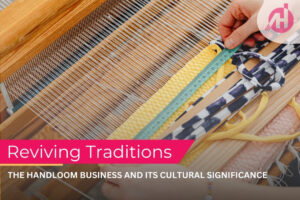The handloom industry, with its rich heritage and artistry, is facing both significant challenges and promising opportunities as it moves into the 21st century. Here’s a look at what the future might hold for this time-honored craft:
Challenges
- Economic Pressures
- Competition with Mass-Produced Textiles: Handloom fabrics often come with a higher price tag compared to machine-made textiles. This price disparity can make it difficult for handloom products to compete in a market driven by affordability and convenience.
- Decreased Profit Margins: The rising cost of raw materials and labor, combined with the need to maintain traditional techniques, can squeeze the profit margins for handloom producers.
- Declining Artisan Numbers
- Aging Workforce: Many handloom artisans are from older generations, and there is a lack of new entrants into the profession. This aging workforce threatens the continuity of traditional skills and techniques.
- Migration to Urban Areas: Young people often migrate to cities for better job prospects, leading to a decline in the rural workforce that traditionally supports handloom weaving.
- Lack of Modernization
- Outdated Equipment: Many handloom weavers still use traditional equipment that may not be as efficient as modern machinery. This lack of modernization can hinder production capacity and quality.
- Limited Innovation: There is often a reluctance or inability to integrate new design trends and technologies with traditional weaving techniques, potentially making handloom products less appealing to contemporary consumers.
- Market Access and Visibility
- Limited Reach: Handloom products can struggle to reach broader markets due to limited marketing and distribution channels.
- Low Consumer Awareness: There is a need for greater consumer education about the value and uniqueness of handloom textiles to drive demand.
Opportunities
- Sustainability and Ethical Fashion
- Growing Eco-Consciousness: With increasing consumer awareness about sustainability, handloom fabrics—being eco-friendly and often produced with minimal environmental impact—are well-positioned to benefit from this trend.
- Ethical Consumerism: Handloom products can appeal to consumers who value ethical production practices and are willing to pay a premium for artisanal, handcrafted items.
- Cultural Revival and Heritage Preservation
- Revitalizing Traditions: There is an opportunity to leverage the cultural significance of handloom weaving to promote heritage tourism and cultural appreciation.
- Support for Artisans: Government and non-governmental organizations can play a role in supporting handloom artisans through grants, training programs, and initiatives that promote traditional crafts.
- Innovation and Modernization
- Technology Integration: The introduction of new technologies and techniques can enhance the efficiency and quality of handloom production, making it more competitive.
- Design Innovation: Collaborations between traditional artisans and modern designers can lead to innovative products that blend classic techniques with contemporary aesthetics.
- Niche Markets and Customization
- Personalized Products: Handloom textiles can cater to niche markets that value bespoke and custom-made products, offering unique designs and personalized experiences.
- Luxury Market: High-end fashion brands and designers are increasingly incorporating handloom fabrics into their collections, creating opportunities for premium positioning and market differentiation.
- Digital Presence and E-Commerce
- Online Platforms: Building a strong online presence and leveraging e-commerce platforms can help handloom producers reach global markets and connect with consumers directly.
- Social Media: Utilizing social media to showcase the craftsmanship, stories, and heritage behind handloom products can increase visibility and attract a wider audience.
Conclusion
The future of handloom weaving is shaped by both its enduring challenges and the exciting opportunities on the horizon. By addressing economic pressures, modernizing practices, and capitalizing on trends in sustainability and ethical fashion, the handloom industry can navigate these challenges and thrive in the modern marketplace. Embracing innovation while preserving tradition will be key to ensuring the continued relevance and success of handloom textiles in the years to come.
4o mini






